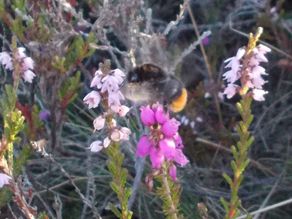Bumble bee forager abundance on lowland heaths is predicated by specific floral availability rather than the presence of honey bee foragers: evidence for forage resource partitioning
DOI:
https://doi.org/10.26786/1920-7603(2018)18Abstract
Honey bees are being scrutinized for their potential impact upon wild bees. In lowland heath mosaics, a simple but resource rich habitat for pollinators, there is a higher probability of niche overlap for bumble bees and honey bees due to the requirement of similar resources and limited floral diversity. This study assesses i) if there is any evidence of forage competition between bumble bees and honey bees and ii) asks to what extent the number of bumble bee foragers in a lowland heath mosaic over the summer months is affected by floral resource availability in different heath types (wet/dry). Bumble bee and honey bee counts were conducted at 30 wet heath and 30 dry heath 20 m × 20 m sites, in the Poole Basin, UK. The relationships between bumble bee and honey bee forager observations and ericaceous forage availability throughout the summer were evaluated using GLMMs considering presence and abundance of honey bees and specific floral availability as factors.
Only weak correlations of honey bee forager abundance on bumble bee forager abundance were detected. Instead, the most important factors relating to bumble bee numbers were the abundance of specific floral resources within the heath type (wet/dry). Bumble bees and honey bees showed resource use consistent with resource partitioning with bumble bees predominantly using wet heaths and honey bees using dry heaths. These findings provide evidence of the importance of maintaining complex habitat mosaics within broader habitats to promote coexistence between bumble bees and honey bees.
Downloads
Published
How to Cite
Issue
Section
License
Copyright (c) 2018 Elizabeth Franklin, Tadhg Carroll, Debborah Blake, Kate Rickard, Anita Diaz

This work is licensed under a Creative Commons Attribution 4.0 International License.
JPE is an open access journal which means that all content is freely available without charge to the user or his/her institution.
Authors who publish with this journal agree to the following terms:
1) Authors retain copyright and grant the journal right of first publication with the work simultaneously licensed under a Creative Commons Attribution License that allows others to share the work with an acknowledgement of the work's authorship and initial publication in this journal.
2) Authors are able to enter into separate, additional contractual arrangements for the non-exclusive distribution of the journal's published version of the work (e.g., post it to an institutional repository or publish it in a book), with an acknowledgement of its initial publication in this journal.
3) Authors are permitted and encouraged to post their work online (e.g., in institutional repositories or on their website) prior to and during the submission process, as it can lead to productive exchanges, as well as earlier and greater citation of published work (See The Effect of Open Access).
To assure a broader targeted audience, content will be included into databases (such as EBSCO) and directories (such as DOAJ).











